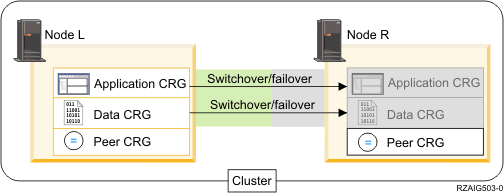This configuration example describes a basic cluster that contains two nodes.
This example configuration provides the following:
- One-way replication and failover
- Two-tier environment
- Applications and data move together
- Backup used for offine processing of data
 Continuous operation on peer CRG
Continuous operation on peer CRG

 Using this example, Node L is currently operating as the
primary node for two cluster resource groups, an application CRG and a data
CRG. It also contains a peer CRG that provide continuous operations for either
node. Two exit programs will be running periodically on Node L for the application
CRG. The reason two exit programs may be running at the same time is if you
call the Start CRG API, an exit program is started and runs continuously while
the application CRG is active. If you should call the End CRG API for the
application CRG, another exit program is then started. Node R is the first,
and only, backup node designated in the recovery domain of each cluster resource
group. Data that is associated with the data CRG and pertinent application
information that is associated with the application CRG is being replicated
from Node L to Node R. If Node L fails or needs to be taken down for administrative
reasons, then a failover or switchover is initiated and Node R becomes the
primary node for both the application and data CRGs. Node R will take over
the Internet Protocol (IP) address defined for the application CRG.
Using this example, Node L is currently operating as the
primary node for two cluster resource groups, an application CRG and a data
CRG. It also contains a peer CRG that provide continuous operations for either
node. Two exit programs will be running periodically on Node L for the application
CRG. The reason two exit programs may be running at the same time is if you
call the Start CRG API, an exit program is started and runs continuously while
the application CRG is active. If you should call the End CRG API for the
application CRG, another exit program is then started. Node R is the first,
and only, backup node designated in the recovery domain of each cluster resource
group. Data that is associated with the data CRG and pertinent application
information that is associated with the application CRG is being replicated
from Node L to Node R. If Node L fails or needs to be taken down for administrative
reasons, then a failover or switchover is initiated and Node R becomes the
primary node for both the application and data CRGs. Node R will take over
the Internet Protocol (IP) address defined for the application CRG.